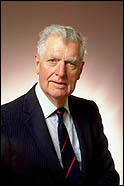So who is this guy?
| Richard Tomlinson is probably one of the most accomplished men you have never heard of. Until yesterday.
 Richard Tomlinson
Richard Tomlinson
| |
Despite forging successful careers in both academe and business, Tomlinson doesn't make much noise about himself.
"He really doesn't want people to make a fuss about him," says Vice-Principal (Development and Alumni Relations) Derek Drummond.
McGill's relationship with Tomlinson goes back to the early 1940s when Tomlinson's father arranged for his promising son to meet with an acquaintance of his, the legendary McGill chemist, Otto Maass.
Tomlinson's father wanted Maass's advice about his son's future prospects. Maass quickly sized up the young Tomlinson and declared that he would see Tomlinson again in a few years -- when Richard was ready to begin his graduate studies.
Tomlinson enrolled at Bishop's to do his undergraduate degree. Out late one night with some buddies, Tomlinson tried to climb back into his dorm room, accidentally crawling through the window of a not-amused school official in the process. He earned a two-week suspension and then went on to earn the Governor General's and Lieutenant Governor's medals as the top student in his class. Fellow students voted him "most likely to succeed, "most brilliant," and "biggest bluffer."
Tomlinson soon encountered Maass again -- during World War II, he served in the Canadian military's Chemical Warfare Unit, headed by Maass.
After the war, Tomlinson became Maass's PhD student. He earned his doctorate from McGill in 1948.
As he completed his degree, Tomlinson recalls being invited to a reception at the Faculty Club for the department's new graduates. He arrived with his date and soon became alarmed when he noticed that all eyes in the room were turning towards him. Tomlinson hadn't been informed that he had been selected to give a valedictory address or that he was being called to the podium.
"I had to wing it. But I learned, when it comes to speeches, you don't have to talk for long and you can get away with it."
After post-doctoral fellowships at the National Research Council and Cambridge, Tomlinson joined McMaster University's chemistry department in 1950.
He became chair of the department and taught at the university for close to four decades. He earned a teaching award from the Chemical Institute of Canada and published almost 60 peer-reviewed papers dealing with subjects as diverse as molecular diffusion and flow, polymer chemistry, the geological age of minerals and chemistry in molecular beams.
He was made an emeritus professor in 1988 and retired the year after. Then he got busy building a whole new career for himself.
"When I retired as an active professor, I decided I wanted to keep doing research. I began doing research on how to make money. I got plenty good at it," Tomlinson chuckles.
He became a founding director of Gennum Corporation which went on to establish itself as the world's largest maker of microchips for hearing aids and one of the biggest suppliers of chips for digital signal-processing TV studio equipment.
Part of Tomlinson's success can be attributed to how he dealt with his staff. Long before the advent of dot.com firms that offered stock options to employees, Tomlinson and his partners offered their workers free equity in the company. "My philosophy has been to invest in people rather than in things, and my faith in these employees has been vindicated," Tomlinson told a Bishop's University newsletter.
Tomlinson has retired from Gennum and much of his gift to McGill consists of his stock holdings in the company.
An avid golfer and runner (he held the national record for the 30-kilometre run for those over 60), Tomlinson is now busy with a new project.
When McMaster's nuclear reactor lost its government funding and was threatened with closure, Tomlinson approached the university with a proposal. Instead of spending millions to close the facility, Tomlinson suggested "we use it to make millions instead."
Tomlinson is busy using the reactor and his own research approaches to develop radioactive iodines and nuclicides used widely in the treatment of cancers and various diagnostic medical procedures. Tomlinson is now on track for creating fortune number two.
"He's far from finished," notes Dean of Science Alan Shaver. "He's got all kinds of ideas. When he starts something, you pay attention to it."

